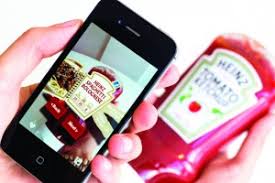From fast food restaurants to consumer-packaged goods, companies are embracing augmented reality packaging to enhance their brands and improve buyers’ experiences. Package designers have taken advantage of augmented reality packaging to create a fun and engaging customer experience. This integration of technology with packaging helps to bridge the digital world with the physical, grabbing customers’ attention at the ever-important point-of-sale.
Debunking the Tech: Augmented Reality vs. Virtual Reality
 While they sound similar, there are a few key differences between these two technologies. Virtual reality (VR) creates an immersive, three-dimensional, computer-generated environment. It is most commonly used in gaming applications. These simulated environments often require the user to wear special helmets, glasses, and gloves in order to interact with the setting.
While they sound similar, there are a few key differences between these two technologies. Virtual reality (VR) creates an immersive, three-dimensional, computer-generated environment. It is most commonly used in gaming applications. These simulated environments often require the user to wear special helmets, glasses, and gloves in order to interact with the setting.
Unlike VR, augmented reality uses technology to enhance a user’s existing environment by superimposing an image or animation over the user’s view of the real world. It can display animations and product features on a screen surrounded by the product’s actual environment. And while AR can be administered using wearable technology like Google Glass or Microsoft’s HoloLens, it is commonly accessed on smart phones and tablets. Augmented reality packaging presents benefits which include improved brand loyalty, increased customer attraction, and the ability to cut through the noise and stand out among competitors. It allows customers to use the devices they already have to access special features of a product or its packaging.
Uses for Augmented Reality Packaging
 The most common uses of augmented reality packaging include short term promotions. Because the technology is still in the early stages of adoption, it can be costly to implement long-term AR campaigns. By using AR for short term promotions, brands can seize customers’ attention while preserving the novelty value of the technology.
The most common uses of augmented reality packaging include short term promotions. Because the technology is still in the early stages of adoption, it can be costly to implement long-term AR campaigns. By using AR for short term promotions, brands can seize customers’ attention while preserving the novelty value of the technology.
AR is a great tool for adding entertainment value as well. For example companies can add games to packaging for kid’s cereals, snacks, or fast food packaging.
In addition to adding entertainment value, AR also has more practical applications. Augmented reality can be used to reduce packaging by communicating necessary details such as nutrition information and cooking instructions through the app rather than printed on the package. As companies adapt to consumers becoming more socially and environmentally conscious, this will be of greater importance.
AR to Drive Impact: Real-World Examples
- McDonald’s used AR in their French fry packaging surrounding the 2014 World Cup. The company used the technology to create soccer game that used an image on french fry containers as the goal.
- 19 Crimes Wine has been using AR to add stories to the characters featured on their bottle labels.
- Cadbury used AR to reinvent their advent calendars for the Christmas, 2017 season.
- Heinz used AR to incorporate recipes for their products.
Considerations When Designing Packages Featuring AR
- What is the goal? Before beginning the AR design process, it’s important to consider what the goal of the campaign will be. Augmented reality packaging can serve many purposes including getting customers’ attention, providing entertainment, or informing customers of important information.
- Who is the customer? Another key consideration when designing for AR is who the customer is. The application and the communication of the goal is going to be different depending on the audience it serves. A game designed to entertain a child who is shopping with their mother will be different than an AR experience designed to let an adult shopper virtually try on a piece of clothing. The design and the app need to align with the customer who will be using them to deliver the most value.
- How will customers access your content? Currently, it is most likely that customers will access your content on their smart phones. But as technology advances and proliferates, it will be increasingly likely that customers will be accessing your content through the use of wearable technology such as specialized glasses.
- How does the content support your brand? It goes without saying that your AR content should support your brand. Whether it’s your goal to build awareness, catch the attention of shoppers at the point-of-sale, or provide a source of novelty and entertainment, it is important to make sure that your content is aligned with your brand message and values. The colors, fonts, and styling used should match your brand, as should the value you will be delivering.
- What is the budget? Depending on the level of detail, augmented reality can come at a higher investment than traditional packaging design. For that reason, it’s important to allocate enough budget. The more detailed and advanced the technology, the greater the cost will be to develop. However, because AR packaging is still in its early stages, it provides a unique selling point for many customers. The novelty of AR will get customers' attention, while the value your company delivers through AR will help make the sale.
- How long will your AR campaign run? Another consideration that will likely impact the cost of designing and maintaining your AR campaign is the duration for which it will run. Because apps often require ongoing support, a longer-running campaign will likely have a higher support cost than a shorter-running campaign.
Conclusion
While the use of augmented reality packaging is still in the early stages of adoption, it is growing in popularity among designers of packaged products. AR benefits brands by creating a novelty that catches customers’ attention and builds awareness and loyalty. As the adoption of the technology progresses among customers and brands, it will likely be used to provide essential information online and reduce packaging. The future looks promising for this growing technology.
Contact us to learn how the experts at Mold-Rite can help you improve your shelf impact and add new innovation to your package designs.



